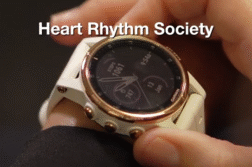BALTIMORE, Md. (Ivanhoe Newswire)— Aortic aneurysms are often caused by hardened arteries and can develop slowly over time. In many cases, patients don’t know they have them. The danger is the balloon-like bulge in the aorta can suddenly burst. Now, researchers are testing a device to fix some aneurysms, from inside the body, without requiring open surgery.
It’s a life-threatening situation but many people with aortic aneurysms may have no symptoms.
“The problem with the bulging of the aorta is it doesn’t have pain fibers. So, people don’t know that they already have aneurysm, and they don’t know that their life is in danger. So, it’s really a silent assassin,” Shahab Toursavadkohi, MD, a vascular surgeon at the University of Maryland Medical Center, told Ivanhoe.
Currently, the traditional fix is open surgery, a complicated procedure. But now, researchers are testing a repair system they refer to as thoracoabdominal branch endoprosthesis or TAMBE. It’s designed for patients with aneurysms that extend from the chest to the abdomen. During the TAMBE procedure surgeons enter the body through a small incision in the groin, and with a catheter, snake small parts of the device inside.
Dr. Toursavadkohi explained, “It’s like you’re assembling a Lego house inside the body without opening the body. How you do it, you put small pieces inside and you do the assembly inside.”
When the pieces are assembled, they prop open the weakened arteries and the bulge deflates.
“It’s like you’re taking air out of a balloon that is under tension, and then balloon becomes soft and it collapses,” Dr. Toursavadkohi stated.
Meaning the aneurysm is no longer a threat to the patient.
Researchers are enrolling a total of 102 patients in centers across the country who will be followed for five years after the TAMBE procedure. The University of Maryland School of Medicine surgeons have performed three TAMBE procedures, and say their patients are all doing well.
Contributors to this news report include: Cyndy McGrath, Producer; Kirk Manson, Videographer; Roque Correa, Editor.
To receive a free weekly e-mail on medical breakthroughs from Ivanhoe, sign up at: http://www.ivanhoe.com/ftk
Sources:
https://www.goremedical.com/products/excluder
https://clinicaltrials.gov/ct2/show/NCT03728985
MEDICAL BREAKTHROUGHS
RESEARCH SUMMARY
TOPIC: TAMBE STOPS THE AORTA’S SILENT ASSASSIN
REPORT: MB #4945
BACKGROUND: An abnormal bulge which occurs in the wall of the aorta that carries blood from the heart to the body is known as an aortic aneurysm. These aneurysms can occur anywhere in the aorta and may be tube-shaped or round. Aortic aneurysms include abdominal aortic aneurysms which occur along the part of the aorta that passes through the abdomen, and thoracic aortic aneurysms which occur along the part of the aorta that passes through the chest cavity. An aortic aneurysm increases the risk of developing an aortic dissection. This is when a tear develops in the inner layer of the wall of the aorta and causes one or more of the layers to separate, which weakens the wall of the aorta. Having an aortic aneurysm also increases your risk that the aneurysm can rupture.
(Source: https://www.mayoclinic.org/diseases-conditions/aortic-aneurysm/symptoms-causes/syc-20369472)
RISK FACTORS: Certain risk factors and lifestyle choices increase the risk of developing an aortic aneurysm. These include hypertension, age, gender, smoking, elevated cholesterol and triglycerides, inactive lifestyle, and obesity. There are specific factors that can increase the risk including a history of arterial aneurysms in other blood vessels, family history of aneurysms (especially in families that have a genetic predisposition), bicuspid aortic valve, or a history of chronic inflammatory disease. For aneurysms that are small and slow growing, the risk remains low for rupture. However, for larger aneurysms, the risk becomes much higher. It’s like when you first begin blowing up a balloon. The more you expand the balloon, the easier it becomes to make it larger. But, if you blow it up just a little too much, the wall becomes too thin, and it will eventually pop. Other risk factors that make rupture more likely include atherosclerosis, or the buildup of plaque on the artery walls. Of the lifestyle factors that increase the risk of rupture, smoking is the most dangerous.
(Source: https://www.verywellhealth.com/aortic-aneurysm-causes-and-risk-factors-4160835)
NEW RESEARCH TO SLOW GROWTH: A team at the University of Kentucky College of Medicine is studying the cause behind thoracic aortic aneurysms in hopes of leading to a new treatment. “We hope this research program will contribute to providing new medical options so that watching, and waiting won’t be the only option,” said Alan Daugherty, PhD, chair of the UK Department of Physiology, Gill Foundation Chair in Preventative Cardiology, and director of the Saha Cardiovascular Research Center and Saha Aortic Center in the UK College of Medicine. “This grant gives us an opportunity to find pathways for a drug therapy to stop the aneurysm from growing so patients can avoid surgical intervention.” The key may be in a material called extracellular matrix, which binds aortic tissue together. The extracellular matrix is what degrades to weaken the tissue in an aneurysm, and researchers currently have little understanding about what makes that happen.”
(Source: https://uknow.uky.edu/research/uk-research-could-lead-treatment-aortic-aneurysms)
FOR MORE INFORMATION ON THIS REPORT, PLEASE CONTACT:
BILL SEILER
410-328-8919
If this story or any other Ivanhoe story has impacted your life or prompted you or someone you know to seek or change treatments, please let us know by contacting Marjorie Bekaert Thomas at mthomas@ivanhoe.com




